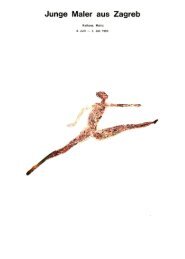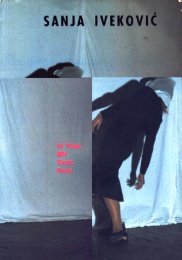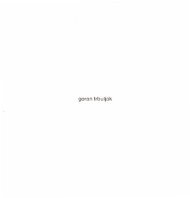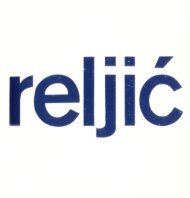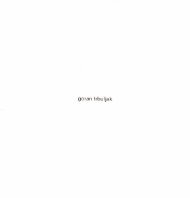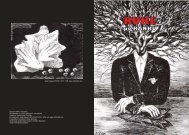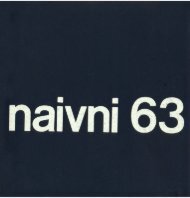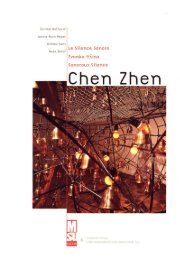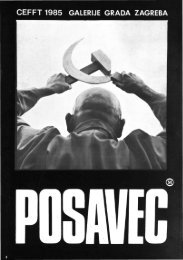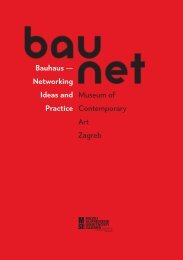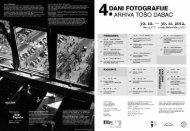The Misfits.pdf - Muzej suvremene umjetnosti Zagreb
The Misfits.pdf - Muzej suvremene umjetnosti Zagreb
The Misfits.pdf - Muzej suvremene umjetnosti Zagreb
You also want an ePaper? Increase the reach of your titles
YUMPU automatically turns print PDFs into web optimized ePapers that Google loves.
does not offer a social utopia but, on the con-<br />
trary, provides a personal "daily" utopia made<br />
in the context of social limitations and per-<br />
sonal attitudes.<br />
Misunderstanding<br />
Although Martinis in his video and multimedia<br />
works often deals with communication, the<br />
purpose of these works is not communication.<br />
In installations and video art from the 1980s<br />
(Sic Transit. 1981, Image Is Virus, 1983) and par-<br />
ticularly the 1990s (<strong>The</strong> Line of Fire, 1994:<br />
Coma. 1997; Binary Series, 1998). Martinis used<br />
communication to create an autonomous<br />
(metaphorical) work, rather than to convey a<br />
message. In the video installation <strong>The</strong> Line of<br />
Fire, the faces in slow motion spout fire, not words.<br />
In the Binary Series of installations and multimedia<br />
actions. Martinis encodes the message using the<br />
binary principle of the Morse alphabet or the digi-<br />
tal code system of digits 1 and 0. <strong>The</strong> messages are<br />
accessible only to those who can decode them.<br />
Although binary codes are the foundation of mod-<br />
ern technology and global progress. most users of<br />
technology have no knowledge of its language. In<br />
the video installation To America Say.33 2001.<br />
what we see on the screen is the title of Hollywood<br />
film King Kong. edited so that identical frames alter-<br />
nate at a varied pace with minimal changes. It is,<br />
however, clear that behind this sequence is a bina-<br />
ry coded message. Although this may seem like a<br />
tautological procedure in which the work is con-<br />
cerned with itself, its in-depth, subversive dimen-<br />
sion charges it with a poignant social commitment.<br />
With these works Martinis touched upon a number<br />
of sensitive issues concerning global and individual<br />
freedom, equality and distribution of power.<br />
THE MISFITS I 14<br />
Art as total non-art<br />
Community Art started out in 2001 when an artistic<br />
group34 of the same name was founded. Evolved<br />
from the several years long project of Weekend Art,<br />
its goal was to prompt communication that would<br />
aid development of new and better relationships<br />
between individuals and communities. <strong>The</strong> strategy<br />
of this group may be said to inaugurate a new<br />
model of "total non-art" in which everything is sub-<br />
ordinated to forms of communication, dialogue and<br />
exchange, interaction and partnership with the aim<br />
of creating new communities that would perhaps<br />
have the character of a new form of art.<br />
Andreja Kulunit devoted several multidisciplinary<br />
projects. such as Closed Reality - Embryo (1999-<br />
2000) or the recently started Distributive<br />
lustice36 (2001-) to exploration of the possibil-<br />
ities of expression and new fields of action<br />
provided by online communication. For the<br />
majority of cyber space users, the virtual<br />
world ends when the monitor, an interface<br />
between the real and the virtual, is shut down.<br />
This is not quite accurate as it is based on a<br />
misconception that virtual space is an entirely<br />
new space, separate from reality. In fact, virtu-<br />
al space is just a mirror for reality: whatever<br />
exists in the real world is also there in the vir-<br />
tual one. <strong>The</strong>y are partly differentiated by<br />
their image, but structurally they are both<br />
constructed of data and pure information.<br />
Closed Reality - Embryo is an interactive proj-<br />
ect of fictitious content that supplies tools to<br />
design an utopian human being (embryo). a<br />
"custom made" baby. <strong>The</strong> online project was<br />
accompanied by discussions, lectures and<br />
workshops which analyzed the various levels<br />
and aspects of the project, from the ethical<br />
dimension of bioengineering and cloning to<br />
the relation towards socio-cultural context<br />
and its impact of self-construction.<br />
In the project Distributive justice Andreja



